An employee innovation program is plainly defined as:
An ongoing, collaborative program where employees continuously submit ideas on innovation initiatives and important aspects of business. Then, those ideas are filtered, iterated on, assessed, and implemented by ad-hoc innovation teams with input from other stakeholders.
Note that each part of that definition is important. In other words, a good employee innovation program is characterized by:
The ability to churn out new innovative ideas consistently.
Ideas being connected to topics and initiatives relevant to current business priorities.
A large proportion of employees involved and engaging in the process, not just a handful.
We’ve been consulting with dozens of businesses (growing brands to global companies) on collaborative and innovative solutions for over a decade, so we wrote this post to outline the three major mistakes teams make when developing an employee innovation program and what we’ve learned to be the best solutions.
Mistake #1: Not Following a Strategic Approach to Idea Collection
Most innovation departments we talk to have an open-ended idea collection process, where employees can submit ideas to a survey form, email inbox, or portal.
While this is better than not having any idea collection system, the problem with this method is that many employee ideas are not tied to the goals of your innovation strategy — they’re just on random topics that are top of mind for the employee at that moment.
For example, if the innovation department is currently looking for operational ideas to reduce cost or environmental ideas to reduce manufacturing waste, there’s little chance that an open call to submit ideas will produce suggestions in those categories without explicitly informing employees of those priorities.
Moreover, since the ideas submitted are all over the place, more often than not, innovation departments can’t follow up on them or even provide meaningful feedback, which leads to frustration from the authors and ultimately harms engagement. No one likes to participate in a “black-box” innovation system without feedback.
Solution: Share the Goals of Your Innovation Strategy So Employees Can Submit Ideas & Feedback Tied to Specific Initiatives
A critical to-do when creating your innovation strategy is to share the big-picture goals or problems you want to solve with other employees in your organization. Everyone in the organization should have a clear idea of the innovative vision to know where the company wants to innovate the most.
Then, idea gathering transforms into collective brainstorming and problem solving — innovation departments can ask questions about specific topics or present current issues to get perspectives from all corners of the company and uncover previously unimagined ideas.
A key feature we’ve designed in our platform to support this is something we call “Innovation Challenges”. Managers can create postings about innovative initiatives and call on employees to share their best ideas.

Our platform lets authors add background details, images, videos, attachments, and any other information they feel is helpful for conveying what their ideas are for.
Innovation managers can also customize idea submission forms and require employees to provide specific details about their ideas before they can submit to help them communicate key factors, allowing managers to see more “well-rounded” responses and weed out ones that are less relevant.
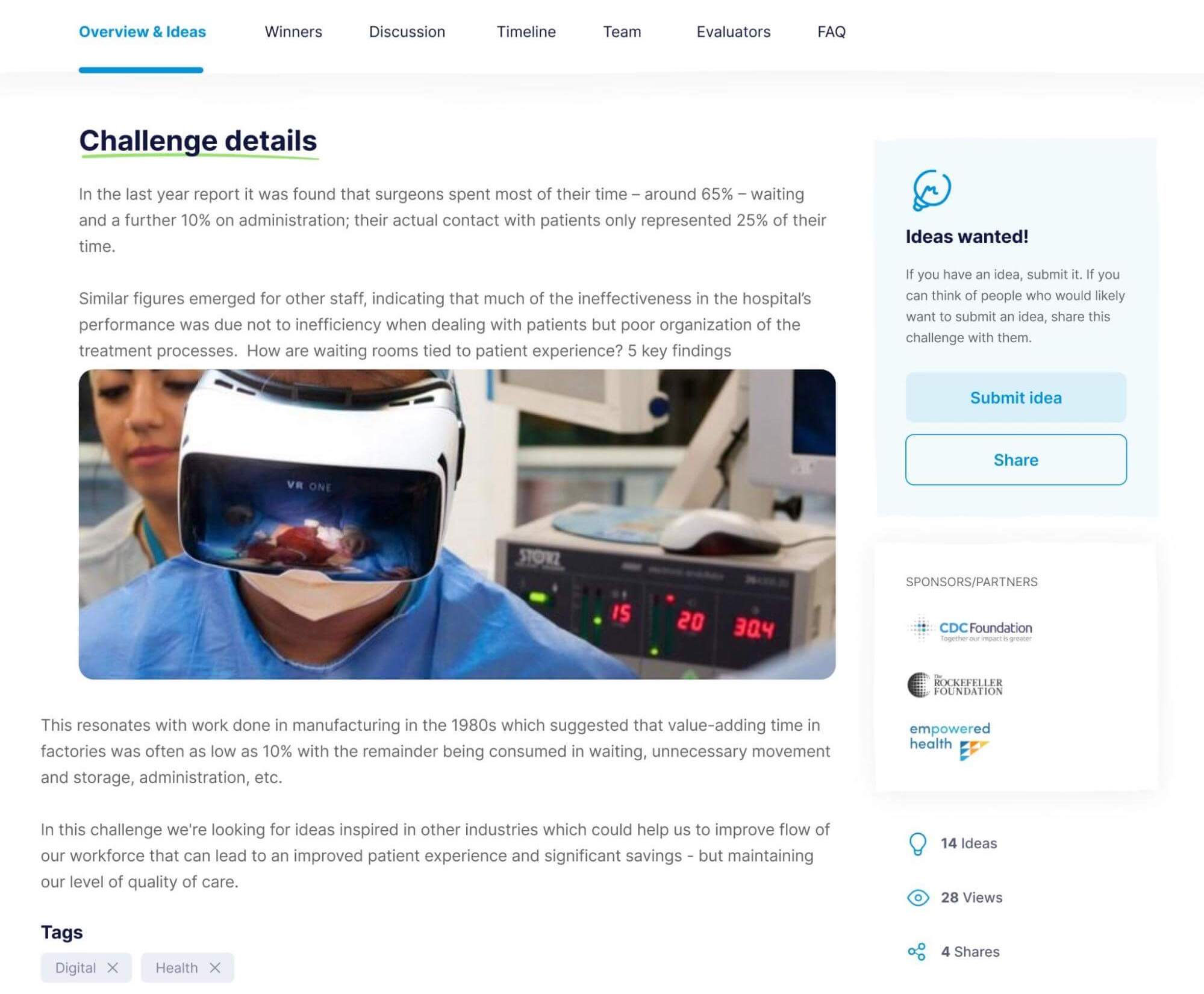
Finally, managers can set due dates for idea submissions to create a sense of urgency and encourage employees to get involved.
Challenges — and all shared ideas — can be posted publicly so employees can easily see what others have said, submit new ideas, and collaborate.
We also design our feedback tools to facilitate constructive conversations and help employees improve each others’ ideas. This helps reduce the burden on innovation departments, as employees can help identify the most promising ideas, ask each other tough questions, and work with colleagues to improve ideas.

Instead of merely a voting tool, we prompt employees to provide an explanation for their vote so other users can see the details, and authors of the ideas can use those details to improve their submissions.
Authors can edit ideas so everyone can see the most recent version; innovation managers can track feedback and see how the idea evolved in the version history.
Authors of ideas can acknowledge the co-workers who helped improve their ideas by marking them as significant contributors. (Employees can even submit ideas together as co-authors, or add significant contributors as co-authors.)
This allows not only managers to see who had significant contributions, but, critically, it helps employees stay engaged and feel valued even if they didn’t have ideas to submit themselves.
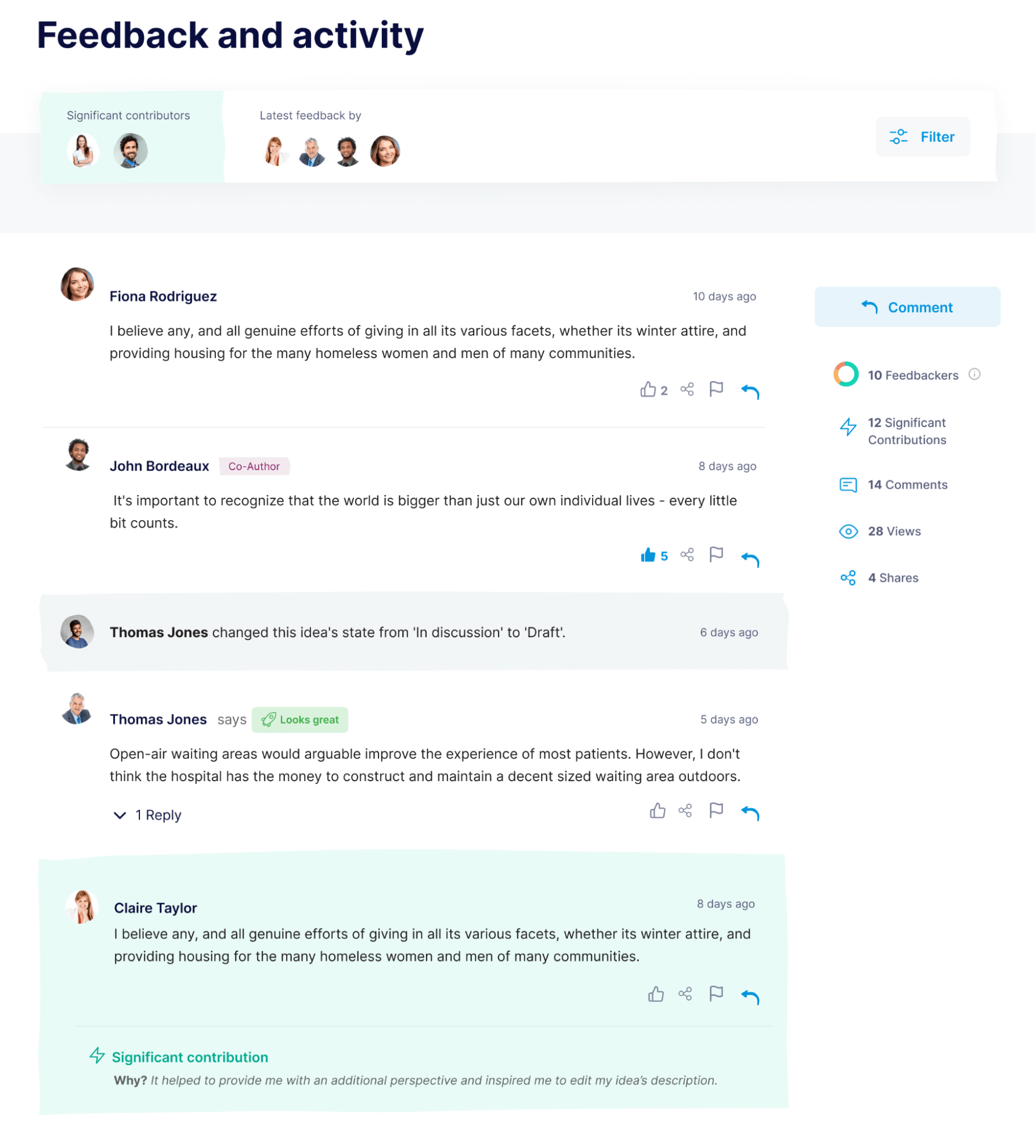
Open-ended idea collection can also be made more focused by designing custom idea submission forms that require employees to categorize and answer questions about their ideas before submitting. This can help weed out the not-so-relevant submissions or simply help managers bucket ideas into their respective categories. You can also design open-ended idea submissions to inform employees of current initiatives and encourage more submissions in those categories.
We’ve done that in InnovationCast with an “Always On” idea submission model organized around specific idea categories with customizable forms and workflows that allow employees to submit ideas they feel are helpful for the business. All ideas are posted to the public feed for others to see and provide feedback.
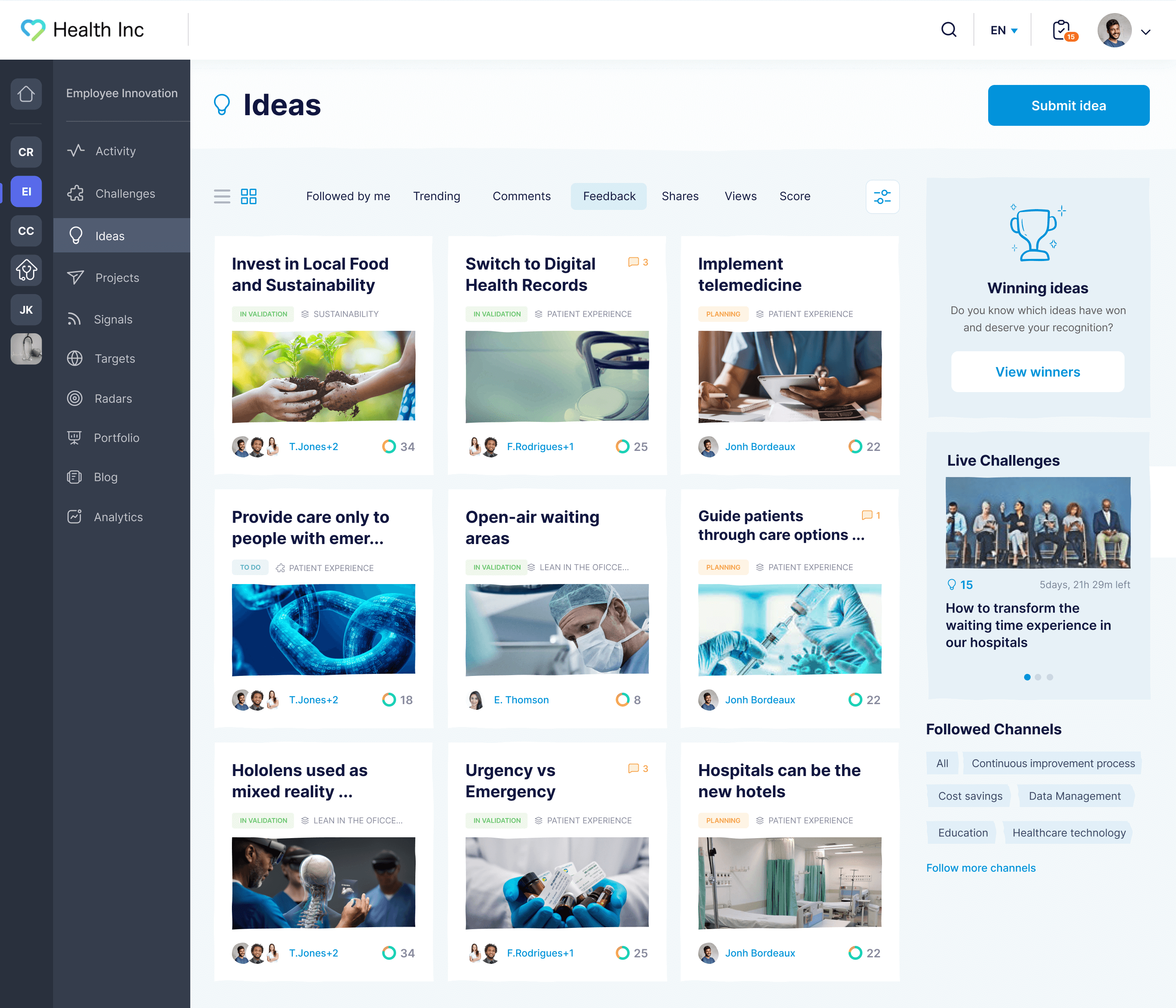
Mistake #2: Not Having Processes for Assessing & Implementing Ideas After Idea Collection
Another mistake we often see is innovation departments not having clear plans or processes for launching ideas. They typically manage the steps after ideation internally, and they decide these steps on a per-idea basis (or only follow a loose workflow).
Also, from what we’ve observed, transparency and collaboration often crater when it comes time to work on the most promising ideas — those ideas are just given to the respective departments who are left to do with them what they please; the employee who submitted it often lose all visibility and other contributors also can’t track what happened to their idea.
While this ad-hoc approach may work to a degree, it leaves a ton of opportunity on the table for innovation teams — they might be sitting on a treasure trove of good ideas but haven’t set the right foundations to bring them to fruition or actually drive innovation.
Without clear processes to launch innovation ideas or a system that includes a wider employee base helping to work on idea assessment and validation, innovation teams or managers often can’t give proper attention to all the greenlit ideas in their pipeline. Ideas end up stalled somewhere between evaluation and execution, or it takes months to bring an idea to life. Then, ideas grow stale, and engagement is down because nothing seems to be happening.
Solution: Establish Clear Workflows for Each Innovation Type or Category of Idea
Another component of creating an innovation strategy is developing processes to support your innovation projects.
Different categories of ideas will require different processes to execute. Your approach to learning about and implementing new technologies within your organization will differ from your approach to changing your business model — so you need to devise clear workflows for each type of innovation project you see on your radar.
To determine what works best for you, think about the categories of ideas you’re collecting, the goals of your innovation strategy, and the types of innovation projects you anticipate.
Is your focus on revamping your products or services? Designing new products? Improving the customer experience? Are you wanting to make operational changes?
Then, you want to design the workflows to implement those ideas, including all required steps from idea collection to launch. Here’s a general framework:
Idea collection & feedback, where employees submit ideas and collaborate on fine-tuning each others’ submissions.
Idea assessment & selection, where innovation managers and other stakeholders evaluate ideas against pre-set criteria to determine feasibility and potential impact, then vote on which ideas to move down the line.
Idea testing & validation (a must-have safeguard to avoid failure): this step allows teams to explore ideas with high degrees of uncertainty. Innovation managers can involve other departments to determine potential constraints, run experiments, conduct customer interviews, mock-up product designs or prototypes, perform financial risk analyses, etc.
Project planning & management, where innovation departments plan the tasks to execute greenlit ideas and report on outcomes. These are typically variable by project.
As described in the Testing & Validation bullet, each step can include complex, lengthy tasks; you must determine what needs to happen at each stage and who needs to be involved before ideas can move to the next phase.
Here’s an example workflow for general business improvements (aka continuous improvements):
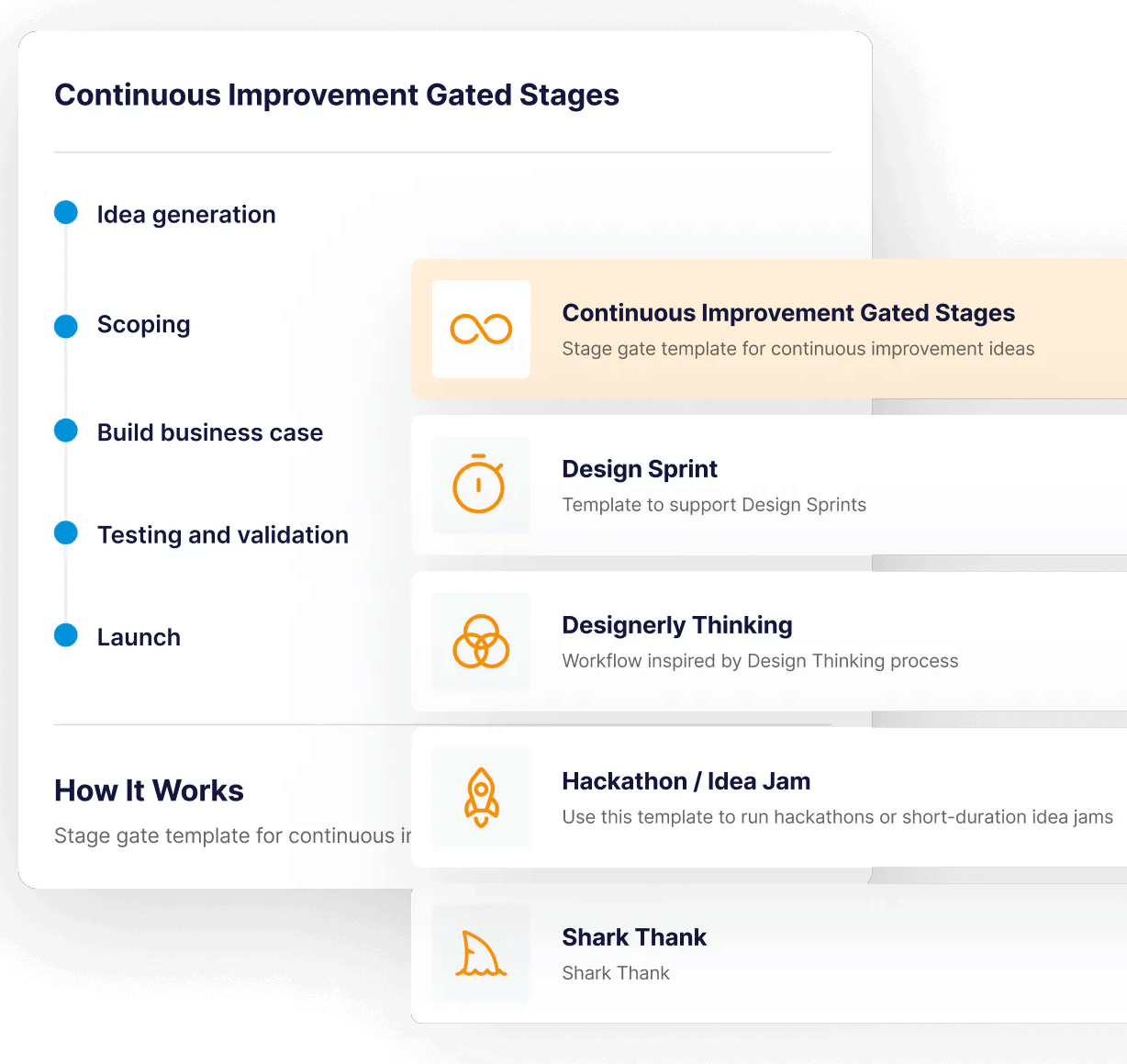
Establishing innovation workflows ensures all employee ideas are assessed fairly and follow standardized implementation steps; employees can see feedback, and if ideas are passed down the line, then they can see the impacts of their contributions.
Our team can plan these workflows with you (or model and improve your existing workflows) and show you how to configure our innovation management platform to support your exact processes.
Our platform lets you specify the steps in each workflow and choose the inputs and users required at each step. Then, our automation features pass ideas down the line as users complete the necessary action items.
In addition, our platform lets innovation departments manage the tasks at each stage of their workflows directly within our platform, and we have native project management tools to plan implementation.
This allows organizations to keep all management of the idea incubation workflow inside the platform and not “take it offline” when an idea reaches a certain stage of maturation (which is extremely common). Keeping it all on the platform helps with transparency and collaboration — the subject of the next section.
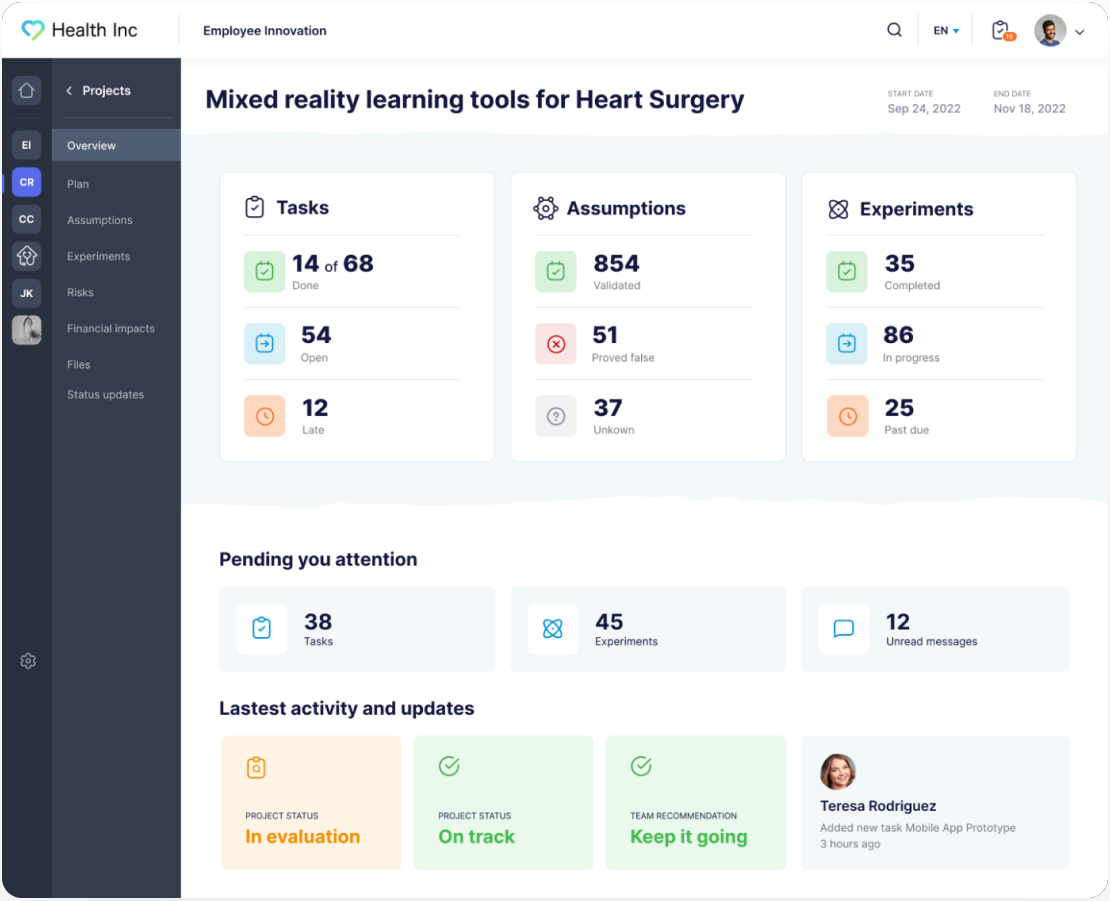
Mistake #3: Lack of Transparency & Collaboration Throughout Innovation Processes
In most organizations, after submitting an idea, employees don’t get much transparency on what happens. Ideas are reviewed by management or a team within the innovation department — so employees can’t see others’ ideas. If an idea is good enough to be given a more intense look, the original submitter may not get updates on what happens to it.
This all serves to leave most employees feeling “out of the loop”, which, understandably, kills engagement and motivation to keep participating in innovation activities. Employees don’t want to feel like they’re submitting ideas for nothing; they want to see what happens with their contributions, if ideas are implemented, and the outcomes of innovation projects.
If employee engagement drops off, innovation teams have fewer and fewer ideas to work with, and the innovation engine slowly comes to a halt.
Solution: Create an “Innovation Hub” to Connect All Users & Innovation Initiatives
Giving employees visibility into the full innovation process creates a sense of unity and lets them feel more involved. You have to engage other departments in innovation projects and maintain transparency through the project lifecycle to build the company-wide “culture of innovation” that so many organizations strive to have.
That means you need a system, and the tools to support such a system, that has those principles of transparency and collaboration in mind. You can’t accomplish these goals if your tools only let users submit ideas to a web form whose responses can only be seen by two or three managers.
In particular, innovation management software lets you establish an “innovation hub” where the organization can manage each phase of innovation processes in one tool.
Employees can each have their own profiles, they can submit ideas, they can see others' ideas and give feedback, managers can select the best ideas to move forward, and the post-idea-collection process of assessment, validation, and more can also be managed in that same platform. This maintains visibility for all users and avoids innovation teams “taking ideas offline” or working on steps in silos.
Our solution, InnovationCast, supports this by allowing an unlimited number of users and sending a series of onboarding emails to introduce users to the platform. You can bring all employees on board, no matter where they’re located, and connect users who otherwise wouldn’t have the ability to collaborate on innovation projects.
Within our platform, employees can:
View new Innovation Challenges and see all new ideas in the Ideas dashboard — then they can submit ideas or leave feedback.
“Follow” ideas to get updates on new comments and monitor ideas as they move through your outlined innovation workflows.
Explore and join Communities. Innovation managers can create communities by topic or user group and specify team members to moderate each community. Then employees can join groups related to their roles and participate in the initiatives that they’re most interested in or have the most knowledge about.
Submit news articles and other resources about the innovation team’s specific areas of interest; information on new startups, emerging technologies, upcoming trends, or competitors. Innovation managers can set “targets” and provide details on the types of information they’re looking for so employees know what’s relevant to share.
View a personalized Activity stream with updates on ideas they follow or communities they’re involved in; they can use keywords, tags, and topics to customize feeds and see all updates relevant to their interests.
These features make innovation initiatives more accessible to employees; they can check on projects at their convenience, and we provide a variety of ways for employees to get involved (beyond submitting ideas).
In addition, our platform has features for innovation managers to create newsletters or blog posts about ongoing initiatives or noteworthy accomplishments and share those with employees. Managers can also use automation tools to send newsletters at a regular frequency.
How to Support Your Innovation Community & Encourage Continuous Engagement
Above are the mistakes we see organizations make that lead to employees feeling like their contributions aren’t valued and what we’ve observed to be good solutions. In addition, there are more tactical ways to maintain long-term employee involvement in your innovation program.
Embrace the Different Ways Employees Can Contribute to Your Initiatives
Not everyone may have a good idea to submit on every topic, but they may be interested in the topic and want to 1) follow others’ idea submissions, 2) comment on or give feedback to ideas where they have an opinion or expertise to share.
Or, other employees may simply be in a privileged position to capture customers’ feedback and be well-tuned on current events and industry news (which could be relevant to the company/department/or a given initiative and could be worth sharing in case it sparks ideas for future challenges).
As a result, a good employee-centric innovation program should have ways for employees to participate in the process besides just submitting ideas.
Our onboarding emails support this by showing users the different options to get involved in innovation activities — our system also sends periodic emails with tips on how to contribute and leave helpful feedback. Then, everyone feels like they have opportunities to join the innovation hub and participate in innovation efforts.
You can also encourage employee participation by rewarding them for different types of contributions (more on this below).
Show Appreciation & Reward Users for Their Contributions
It’s best practice to acknowledge and thank your employees for pitching ideas and lending their time to innovation initiatives.
We recommend creating an incentive program to recognize and reward employees for their participation. You can offer various incentives — monetary or nonmonetary — and create a system to acknowledge employee achievements publicly.
InnovationCast supports this with a badges and rewards system.
You can design badges and award them to employees for achieving certain milestones — for example, after submitting 10 ideas or being marked as a significant contributor a certain number of times. Badges are displayed on employee profiles for other users to see.
You can also create a points system and dish out points for certain accomplishments. After employees earn so many points, they can redeem them for rewards. Innovation departments can choose the rewards to offer: extra PTO days, free lunch on the company, gift cards, merchandise, you name it.
We also have customers who give a share of money back to the authors and whoever helps bring successful ideas to life with skyrocketing engagement levels.

Nudge Users to Stay Active & Offer Tips on New Ways to Get Involved
Employees have dozens of other priorities within their primary roles — so it’s helpful to send periodic reminder emails that encourage users to stay engaged. This prevents the interest in innovative activities from dying down and ensures employees are up-to-date on the latest initiatives.
Newsletters are one way to hold employees’ interest, but InnovationCast also supports ongoing involvement by sending reminder emails when employees have been inactive for a while. These emails prompt employees to log in and check out what’s new; they even include previews of new challenges and updates to catch employees’ attention.
Get Started with an Innovation Expert from Our Team
We’ve worked with small businesses, Fortune 500 companies, and government agencies to develop successful innovation programs and tools that fit their requirements.
Schedule a free call with our team to discuss your goals and see a demo of our platform.
Read more: Innovation Management at most companies is broken. Here’s how we’re fixing it.

